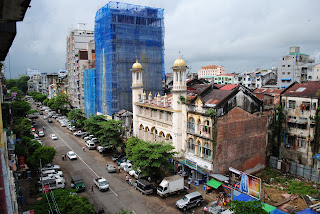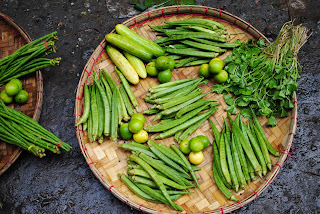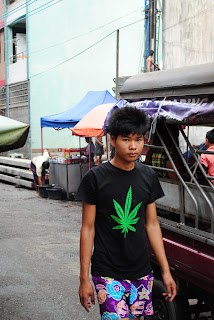-->
-->
Going
to Burma or Myanmar has been on my list of places to go for the past
7 years. At first glance all you can see is men in Longyi (a traditional skirt) or the Tanaka smear or gently applied to woman's faces or babies of both sexes and everywhere is red stains, on the street, in restaurants and in the markets. From the time I was in living in Chiang Mai where many
refugees have moved to or taking the bus for a visa run to the Mae
Sai border crossing and getting to dabble for a couple of hours in
the most isolated country after North Korea always felt like an
exhilaration like dabbling with something off limits. Burma is the
exchange point between India and Southeast Asia. It is a true
melting pot of ethnicities and and cultures. We may see Burma as a
monolithic state when in reality 135 different ethnicities exist
within its borders.
 |
| one of the countless types of ginger |
|
Most recently we are seeing this country move at
a much faster pace than expected towards some type of acceptable
governance so that western governments feel safe enough to invest and
tap the countries 60 million customers. I wanted to visit while I
was living in Thailand in 2005 but at the time this country was still
the pariah of the west and was heavily sanctioned. It just did not
feel like the right time. I was right not to go, because two years
later the Saffron Revolution took place when an incredibly high price
was asked for fuel in a country where people make $30-40 US a month.
 |
| Lamb curry, daal, and fried bread and a small salad of cabbage, carrot and mint |
 |
| Downtown |
 |
| Shoes that were making the street, tar. |
This lead to public demonstrations and reprisal killings by the
government. Then dramatically two years ago the government announced
a whole slew of reforms and suddenly people like David Cameron were
visiting. So I had to go. This was to mean the end of isolation and
the introduction of western products and atms.
I
flew into Yangon in the evening for the next 36 days. Yangon or
Rangoon was built by the British and you can see it everywhere in the
downtown. Unlike Vietnam or other cities that only have vestiges of
their colonial past, Yangon has retained most of its buildings from
these times from old administration buildings to the original markets
built by the British. The historical register is not what has saved
these buildings but instead ineptitude and graft. There is a big
housing shortage in Yangon and there are rumors that some of the real
estate has the same value as that of apartments and houses in
Orlando, Florida.
 |
| Great par-boiled vegetables |
 |
| spicy salad with cauliflower |
 |
| more lamb curry, the food is a bit greasy but you don't have to eat it, it is used as a way to keep the food away from air while it sits out all day. |
I spent most of the next day walking around the
central grid. The city is a smack in your senses. I arrived at the
airport and haggled for my taxi to take me downtown. I had a short
list of places to stay written down and hopped one was available.
Turns out none were available. My gracious taxi driver then
proceeded to call seven more places until we found one in my price
range. This was the first time someone went out of their way to help
me and it would not be the last. This country proved itself to be
one of warmth and generally kind and honest people. I ended up
staying in a hotel that was not very nice in the Indian district.
Yangon and Mandalay have particularly high amounts of decedents from
Indian and Bangladesh. This means a great palate cleanser when you
get tired of eating Burmese food.








One
of the most prized and awe inspiring structures that have been built
is the great Shwedagon Paya temple. After visiting Ankor wat in
Cambodia I thought I was templed out. After Burma I know that I am
templed out. This structure is truly amazing, the amount of gold on
just the temples here is in the hundreds of millions there are also
5,448 diamonds and 2,317 rubies. This extravagant temple is not only
a way for the government to seem benevolent but also a way for them
to exercise their divine power upon the people. It is a very
striking scene be in this temple one min and then back on the street
where you see people living on less than a dollar a day. Where in
the main city you still see children with enlarged stomachs.
Religion is being used as a device to manufacture consent. The
government knows that Buddhism is intertwined with the power of the
government, for example they government has collected a group of very
rare white elephants. The white elephant is a sign of divine power
and the more of them that the government has the better it can stake
a claim to its divine power. All of this is changing and as more
investment and international recognition comes to Burma, these
trappings will have to become looser. Another strange thing about
the city of Rangoon is that in the downtown there are only cars. I
expected to see many motorbikes in Burma like my current home of
Vietnam.
 |
| Heavy Traffic |
 |
| The food is really fresh and green! |
 |
| Chicken Biryani, the best spot I found. Small but really good, great spices! |

I did see motorbikes but only in Mandalay and outside of
Rangoon. For such a poor country you think that you would have to
have motorbikes but the downtown is only filled with cars. Just like
all developing countries that are experiencing new money and growth,
the amount of cars is growing accordingly. I worry just like Ho Chi
Minh city in Vietnam what will happen when everyone can afford a car
but the central government has not built enough roadways to keep up
with demand. The traffic is already bad in Rangoon but with the
additional amount of cars it could be at a standstill in ten years.
For
the next couple of days I walked around the city, exploring the grid
of the downtown. I found old libraries and monasteries tucked on
side streets. Decrepit buildings with clothing hanging out front,
goats eating trash, sewage creeping out of every crack in the street.
The city is obviously burdened by the large amount of people rapidly
urbanizing Rangoon. Once you leave the organized downtown the rest
of the city is winding streets and a mess of urban planning. Unlike
other countries that are considered developing, Burma is not. The
shanty towns extended as far as the eye can see on the fringes of the
city. Landless people trying to make a go of it, by living
precariously on the sides of streets and train tracks. These
landless people will be one of the many roadblocks to full scale
development for Burma.


























































































